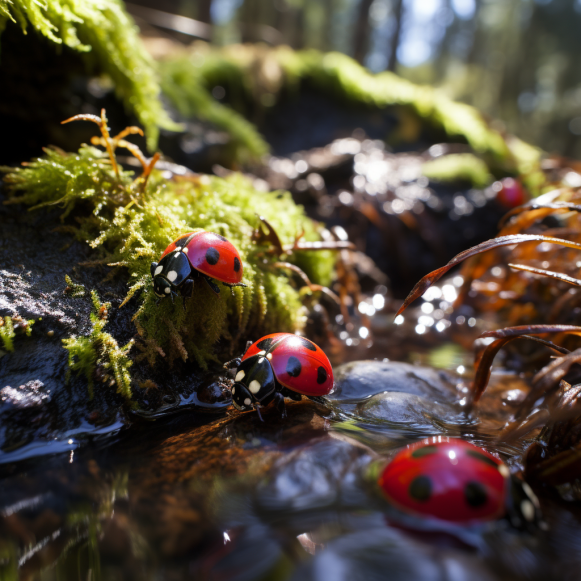Walk on the Wild Side: Birding and wildlife watching in California’s coastal redwood forest

I was hiking alone on a little-known trail high above Mill Valley’s Cascade Canyon this spring. This dense, shady coastal redwood forest is just over the ridge from Marin County’s famous old-growth redwood trees at Muir Woods National Monument.
Despite being a sort of neighborhood, the canyon is also a wildlife haven. This magical forest is home to dozens of species of resident and migratory birds, animals, insects, amphibians, mollusks, and even crustaceans. And you never know what you’ll see on a walk through the redwoods.
I heard a slight hooting sound as I rounded a bend into a deep, shady ravine. I paused to locate the sound before continuing on my way a little further up the trail. To my surprise, I had stumbled upon some of the redwoods’ most elusive creatures: northern spotted owls, a threatened species found mostly in old growth coastal redwoods and Northwest forests.
Amazingly, two fuzzy baby owls — owlets — looked like cute little Star Wars ewoks as they bobbled their heads and warbled in curiosity right above the trail in the hollow of a time-worn redwood tree. Two parent birds were perched in the nearby redwood canopy, keeping a close eye on their young.
Veteran Bay Area birders consider spotted owls to be the holy grail. Seeing fledgling spotted owls was an unforgettable experience.
This was not the first time I’d seen rare owls and other exotic birds in this redwood forest. I’ve seen great blue herons and snowy egrets — birds normally found in San Francisco Bay’s estuaries — fishing for tiny steelhead trout on the trails that follow Mill Valley’s Old Mill Creek. And I frequently see red-tailed hawks and turkey vultures circling the canopy high above, as well as bold Steller’s jays winging among the trees and Anna’s hummingbirds flitting around in high-speed nectar searches. Acorn and pileated woodpeckers, with their distinctive red crests and calls, peck at rotting trees with a rat-a-tat-tat, looking for bugs to eat.
The most common of my favorite birds are tiny Pacific wrens, which hop along logs with their stubby tails held upright, chirping high-pitched notes. They’re adorable and perky, like little redwood forest ambassadors.
The 2 million-acre coastal redwood forest of California, which is unique to the state’s north coast and the extreme southern Oregon coast, is also home to a plethora of small mammals, including bobcats, Western gray squirrels, raccoons, skunks, bats, and medium-sized members of the weasel family, such as Pacific fishers and pine martens. Larger animals, such as black-tailed deer and Roosevelt elk, may also be seen.
I once saw elusive gray foxes and their young emerge from a den beneath the park’s visitor center deck while visiting Muir Woods. Another tick off my redwoods wildlife bucket list, joining black bears and mountain lions.
Previously common amphibians like Pacific giant salamanders, red-bellied newts, and tailed frogs have become less common, at least on my walks, possibly as a result of rising global temperatures. However, garter snakes and slimy, slow-moving banana slugs (the mascot of UC Santa Cruz — Go Slugs!) can still be seen on occasion, with the latter being most common on moist and rainy days.
There are also fish! A unique variety of rainbow trout has adapted to dammed-up waterways in Oakland’s Reinhardt Redwood Regional Park and can still be seen spawning in streams shaded by the park’s redwood trees. Coho salmon spawn in Lagunitas Creek on Mount Tamalpais’ north side each year, and can be seen from the Leo Cronin Fish Viewing Area off Sir Francis Drake Boulevard between Lagunitas and Taylor State Park.
It’s yet another amazing wildlife sighting in our diverse and vibrant coastal redwood forest.
Wear comfortable hiking shoes and bring trekking poles, a good pair of binoculars, and birding, wildflower, and wildlife guidebooks or smartphone apps if you’re going birding or wildlife watching in California’s coastal redwood forests. Any hike in the Bay Area requires a hat, sunscreen, a sack lunch, and plenty of water. The highest resolution images will be produced by a digital camera equipped with telephoto and close-up lenses.
Smartphone apps like Merlin and Sibley provide detailed identification information and illustrations, as well as bird calls, to assist you in identifying a wide range of birds. The latter, which costs $20, contains all of the information in David Allen Sibley’s 644-page “Sibley Guide to Birds,” as well as audio recordings. The app, like its print counterpart, is aimed at die-hard birding enthusiasts. Beginning birders should start with Merlin, a free app created by the Cornell Lab of Ornithology.
The Save the Redwoods League’s free, 81-page birdwatcher’s guide to the coastal redwood and giant sequoia forests, as well as other useful travel guides, can be downloaded from www.savetheredwoods.org under the Experiences tab.
After seeing spotted owls in the redwoods and crossing them off my list, my new goal is to see other rare birds like California condors, peregrine falcons, bald eagles, and, most notably, marbled murrelets, seabirds that strangely split their time between the open ocean and nesting sites high in the canopy of old growth redwoods.
There are so many birds and so little time.
For inexperienced birders, I recommend following the advice of the Save the Redwoods birding guide: “Walk slowly and stop frequently.” Listen. Look. Speak quietly. After all, birds are wildlife, and wildlife is naturally reclusive and retiring. To observe birds, you must immerse yourself in nature.”





